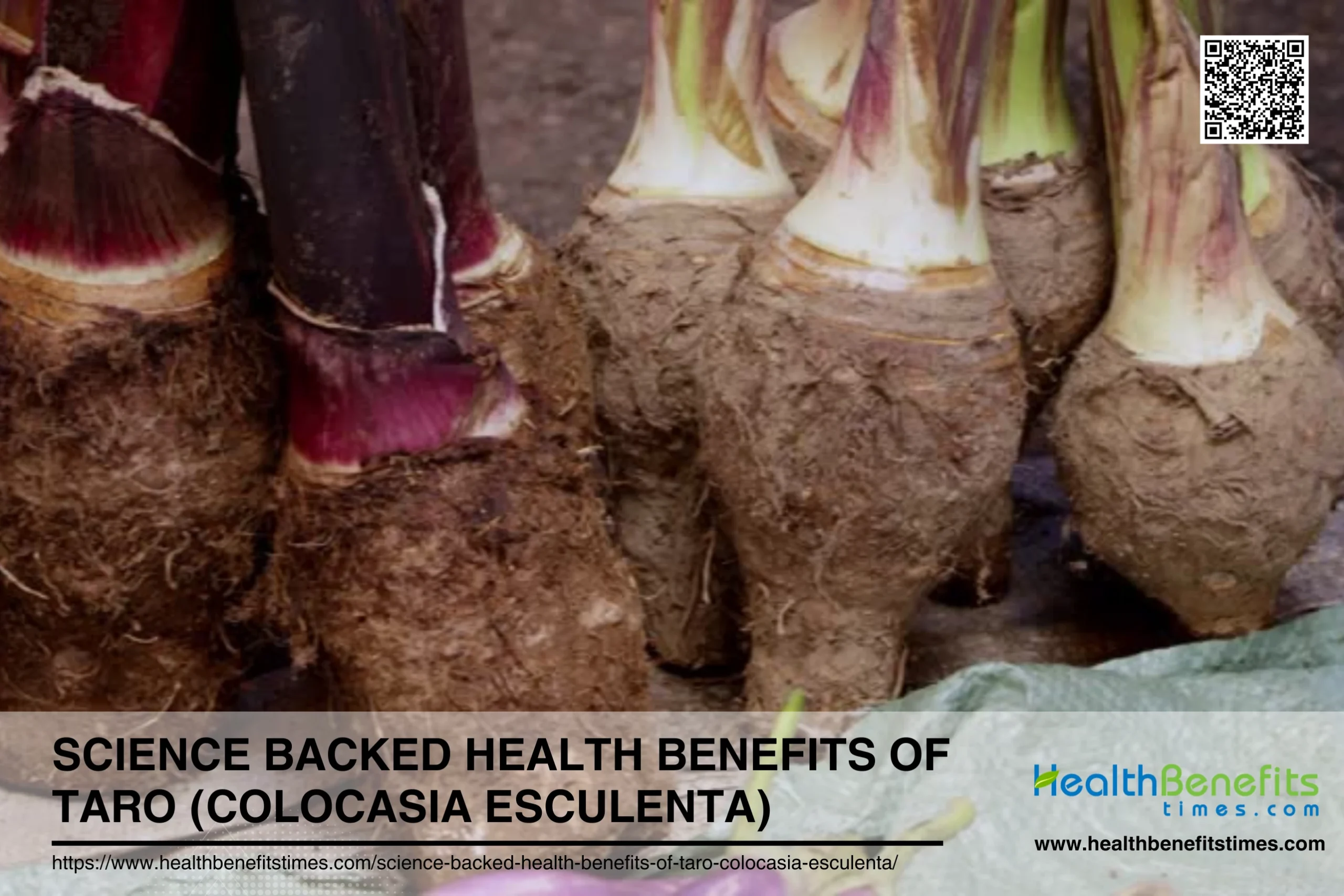- Ancient, polymorphic root crop with edible, medicinal, nutritional, and economic value.
- Five key taro varieties are Colocasia esculenta, antiquorum, affinis, fallax, gigantea.
- Taro is a nutritious root vegetable, supports gut health, reduces cancer risk, aids wound healing.
- Taro helps manage diabetes by regulating blood sugar and insulin sensitivity.
- Taro supports bone health through calcium, magnesium, phosphorus, vitamin C, and potassium.
- Taro is a versatile, nutritious, delicious in savory and sweet dishes, numerous culinary applications.
- Taro is nutritious but raw form causes irritation, allergic reactions, kidney stones.
 Taro (Colocasia esculenta), a starchy root vegetable with a rich history in global cuisines, is gaining recognition for its impressive health benefits backed by science. This versatile tuber, originally cultivated in Southeast Asia and now enjoyed worldwide, is packed with essential nutrients such as fiber, potassium, magnesium, and vitamins A, C, and E. These nutrients contribute to taro’s ability to support digestive health, regulate blood sugar levels, and boost immune function. Additionally, taro’s bioactive compounds exhibit anti-inflammatory, antioxidant, and anticancer properties, making it a powerful addition to a health-conscious diet. Whether you’re managing diabetes, seeking to improve heart health, or looking to enhance your overall well-being, the science-backed health benefits of taro offer compelling reasons to incorporate this ancient crop into your meals.
Taro (Colocasia esculenta), a starchy root vegetable with a rich history in global cuisines, is gaining recognition for its impressive health benefits backed by science. This versatile tuber, originally cultivated in Southeast Asia and now enjoyed worldwide, is packed with essential nutrients such as fiber, potassium, magnesium, and vitamins A, C, and E. These nutrients contribute to taro’s ability to support digestive health, regulate blood sugar levels, and boost immune function. Additionally, taro’s bioactive compounds exhibit anti-inflammatory, antioxidant, and anticancer properties, making it a powerful addition to a health-conscious diet. Whether you’re managing diabetes, seeking to improve heart health, or looking to enhance your overall well-being, the science-backed health benefits of taro offer compelling reasons to incorporate this ancient crop into your meals.
What is Taro ?
Taro is a highly polymorphic and ancient root and leaf crop from the Araceae family, known for its significant edible, medicinal, nutritional, and economic value. It is one of the oldest cultivated crops, with a rich history of use across tropical and subtropical regions. Genetic studies have shown that taro has a complex origin, with evidence suggesting polyphyletic origins in Southeast Asia, and significant genetic diversity particularly in Asian accessions. Taro is cultivated for its starchy corms, which are a staple food in many cultures, and its leaves, which are used in various culinary dishes and traditional medicine. The plant is also valued for its high mineral content, with different parts of the corm containing varying levels of essential nutrients such as potassium, magnesium, and zinc. Despite its importance, taro cultivation faces challenges such as diseases like taro leaf blight caused by Phytophthora colocasiae, which has been reported in regions like Ghana. Advances in genetic research, including the development of a high-quality taro genome, are paving the way for improved understanding and cultivation of this vital crop.
Nutritional Profile of Taro
Taro boasts an impressive nutritional profile that contributes to its growing popularity as a health food. This starchy root vegetable is low in fat and calories while being rich in complex carbohydrates, making it an excellent energy source. A 100-gram serving of cooked taro contains approximately 142 calories, 0.1 grams of fat, 34 grams of carbohydrates, and 0.5 grams of protein. This composition makes taro a suitable option for those looking to maintain a balanced diet or manage their weight while still enjoying satisfying meals.
Key Nutrients in Taro
Taro is packed with a variety of essential nutrients that support overall health and well-being. Its nutrient density is particularly noteworthy, offering a significant amount of vitamins, minerals, and dietary fiber in each serving. The root vegetable is an excellent source of potassium, magnesium, and vitamin C, all of which play crucial roles in maintaining bodily functions. Additionally, taro contains small amounts of calcium, iron, and B-complex vitamins, contributing to its status as a nutritious food choice. The combination of these nutrients makes taro a valuable addition to a diverse and health-conscious diet.
Vitamins
Taro is a rich source of several important vitamins that are essential for maintaining optimal health. It contains significant amounts of vitamin E, a powerful antioxidant that helps protect cells from damage caused by free radicals. Vitamin B6, also found in taro, plays a crucial role in brain development and function, as well as the production of serotonin and norepinephrine, which affect mood. Additionally, taro provides vitamin C, which supports immune function and collagen production. The presence of these vitamins contributes to taro’s ability to support overall health and potentially reduce the risk of chronic diseases.
Minerals
The mineral content of taro is one of its standout nutritional features. Potassium, found abundantly in taro, is essential for heart health, muscle function, and maintaining proper fluid balance in the body. Magnesium, another mineral present in significant quantities, supports bone health, energy production, and muscle and nerve function. Taro also contains manganese, which is important for metabolism, bone formation, and wound healing. The combination of these minerals makes taro an excellent food for supporting various bodily functions and maintaining overall health.
Fiber
Taro is an excellent source of dietary fiber, with a 100-gram serving providing about 4.1 grams of fiber. This high fiber content contributes to taro’s ability to support digestive health and promote feelings of fullness. The fiber in taro can help regulate bowel movements, prevent constipation, and support a healthy gut microbiome. Additionally, the fiber content aids in blood sugar management by slowing the absorption of sugars, making taro a beneficial food for individuals with diabetes or those looking to maintain stable blood glucose levels. The fiber in taro also contributes to heart health by helping to lower cholesterol levels.
Antioxidants
Taro contains various antioxidants that contribute to its health-promoting properties. These include polyphenols, flavonoids, and beta-carotene, which help protect cells from oxidative stress and inflammation. The purple varieties of taro are particularly rich in anthocyanins, powerful antioxidants that give the tuber its distinctive color and have been linked to numerous health benefits, including improved heart health and reduced risk of certain cancers. The presence of these antioxidants enhances taro’s potential to support overall health and may contribute to its ability to reduce the risk of chronic diseases.
Types of Taro
Here are some key varieties of taro with their scientific names:
1. Colocasia esculenta
Colocasia esculenta, commonly known as taro, is the most widely cultivated and consumed species of the Colocasia genus. This variety is prized for its large, starchy corms and broad leaves. It’s a staple food in many tropical and subtropical regions, particularly in Southeast Asia, the Pacific Islands, and parts of Africa. Colocasia esculenta is known for its versatility in cooking, being used in both savory and sweet dishes, and is valued for its nutritional content, including high levels of fiber, potassium, and various vitamins.
2. Colocasia antiquorum
Colocasia antiquorum is sometimes considered a synonym or subspecies of Colocasia esculenta, though some botanists classify it as a distinct species. This variety is known for its smaller corms compared to C. esculenta but is similarly used in culinary applications. It’s particularly popular in certain Asian cuisines and is often cultivated for its leaves as well as its tubers. The plant shares many of the nutritional benefits of C. esculenta and is valued for its adaptability to various growing conditions.
3. Colocasia affinis
Colocasia affinis is a species native to regions including Yunnan, Nepal, Assam, Bhutan, Bangladesh, Myanmar, and the eastern Himalayas. While less commonly cultivated for food than C. esculenta, it holds significance in its native regions for both culinary and medicinal uses. The plant is known for its distinctive leaf patterns and is sometimes grown as an ornamental in addition to its practical applications. Its hardiness in mountainous regions makes it an important crop in areas where other taro varieties might struggle.
4. Colocasia fallax
Colocasia fallax, while not as widely cultivated as C. esculenta, is another species within the Colocasia genus. This variety is known for its smaller size and is often found growing wild in parts of Southeast Asia. While it can be consumed, it’s less commonly used as a food source compared to other taro varieties. C. fallax is sometimes cultivated for ornamental purposes due to its attractive foliage.
5. Colocasia gigantea
Colocasia gigantea, as its name suggests, is known for its large size. This species produces massive leaves and can grow to impressive heights. While it’s not as commonly used for food as C. esculenta, its leaves are sometimes used in certain cuisines. C. gigantea is also valued for its ornamental qualities and is often grown in gardens or landscapes where its dramatic size can make a striking visual impact.
Science backed health benefits of Taro
Taro, a root vegetable cherished in many cultures, is more than just a culinary delight; it’s a powerhouse of nutrition and health benefits. This ancient crop, originally from Southeast Asia, has been a staple in diets around the world for centuries, thanks to its versatility and rich nutrient profile. Modern science has begun to uncover the myriad ways taro can enhance our well-being, from supporting digestive health to regulating blood sugar levels and boosting immune function. In this article, we’ll explore the science-backed health benefits of taro, revealing why this humble tuber deserves a prominent place in your diet.
1. Beneficial for gut health
Taro is highly beneficial for gut health, primarily due to its rich dietary fiber content. A 100-gram serving of taro provides approximately 4.1 grams of fiber, which plays a crucial role in promoting digestive health. This fiber aids in maintaining regular bowel movements, preventing constipation, and supporting a healthy gut microbiome by acting as a prebiotic, which feeds beneficial gut bacteria. Additionally, the fiber in taro helps regulate blood sugar levels by slowing the absorption of sugars, further supporting metabolic health. The presence of resistant starch in taro also contributes to improved gut health by promoting the production of short-chain fatty acids, which are essential for colon health and reducing inflammation.
What Research Says?
- Taro’s high fiber content, particularly resistant starch (RS), promotes the production of short-chain fatty acids (SCFAs) like butyric acid, which are beneficial for gut health.
- The high carbohydrate and protein content of taro, along with essential vitamins and minerals, make it a nutritious addition to the diet, supporting overall health and potentially alleviating malnutrition.
2. Help in reducing cancer risk
Taro shows promising potential in reducing cancer risk, primarily due to its rich content of bioactive compounds and antioxidants. Taro contains valuable molecules effective against cancer and cancer-related risk factors, including carcinogens and biological agents. The main polyphenol found in taro root, quercetin, has been shown in test-tube and animal studies to trigger cancer cell death and slow the growth of several types of cancers. Additionally, taro extract has exhibited the ability to stop the spread of some types of breast and prostate cancer cells in vitro. The anticancer properties of taro are attributed to various compounds, including tarin, taro polysaccharides, α-amylase inhibitors, and other antioxidants. These components display antitumoral, antimutagenic, and immunomodulatory activities, which collectively contribute to taro’s potential in cancer prevention.
What Research Says?
- Taro extracts have shown significant antitumoral activity, inhibiting the proliferation and migration of cancer cells, including gastric adenocarcinoma and breast cancer cells.
- Taro extracts inhibit metastasis in preclinical models of breast cancer, particularly in triple-negative breast cancer, by blocking tumor cell migration and lung colonization.
3. Effective in wound healing

Taro has demonstrated remarkable effectiveness in wound healing, thanks to its rich nutritional profile and unique bioactive compounds. The leaves and corms of taro are packed with essential nutrients, particularly Vitamin E, which plays a crucial role in promoting skin health and accelerating the healing process. Taro’s high antioxidant content helps reduce inflammation and supports tissue regeneration, whether applied topically or consumed. Taro extracts can significantly speed up wound healing by stimulating cell proliferation and collagen synthesis, while also improving overall skin texture. Additionally, taro’s natural moisture-retentive properties contribute to creating an optimal environment for wound healing, making it a valuable ingredient in both traditional and modern skin care remedies.
What Research Says?
- Taro leaves contain metabolites like alkaloids, flavonoids, tannins, steroids, and saponins, which have antibacterial and antioxidant activities that help accelerate wound healing by aiding cell regeneration.
- The phenolic composition and biological properties of taro can be influenced by cultivation strategies, such as variety choice and irrigation conditions. These factors can modulate the accumulation of bioactive compounds that contribute to wound healing by protecting the wound site against oxidative/nitrosative damage and preventing hyaluronic acid degradation.
- Taro leaf stalk extract was compared with gentamicin sulfate cream in wound healing. The study found that while taro extract was effective, the difference in wound area reduction between the taro extract and the control (NaCl) was not significant, suggesting that taro extract maintains wound moisture effectively.
4. Beneficial for managing diabetes
Taro shows promising potential in managing diabetes due to its unique nutritional profile and beneficial effects on blood sugar control. The root vegetable contains resistant starch and dietary fiber, which help slow down digestion and absorption of carbohydrates, preventing sharp spikes in blood glucose levels. Taro has a relatively low glycemic index of 58, making it a better choice compared to other starchy vegetables for people with diabetes. The high fiber content, approximately 4.1 grams per 100 grams of taro, aids in regulating blood sugar levels and improving insulin sensitivity. Additionally, taro contains important minerals like potassium and magnesium, which play a role in glucose metabolism. Taro leaf extract may have antidiabetic properties, though more research is needed in this area.
What Research Says?
- Taro leaves have been shown to help control blood glucose levels when added to food products like white bread, reducing the blood glucose response compared to white bread without taro leaves.
- Taro corms have a medium glycemic index (eGI of 63.1), making them a good dietary carbohydrate alternative for diabetic individuals due to their high starch content and digestibility.
- The presence of cyanoglucoside in taro leaves contributes to their hypoglycemic efficacy, supporting their use in traditional medicine for diabetes management.
- Taro leaves and corms are rich in antioxidants, which can help mitigate oxidative stress, a common issue in diabetes. The antioxidant activity of taro corms and leaves has been documented, with significant scavenging activity against ABTS and DPPH radicals.
5. Help prevent infections

Taro is effective in preventing infections due to its impressive antibacterial properties and immune-boosting nutrients. The leaves and corms of taro are rich in secondary metabolites, such as alkaloids, flavonoids, and saponins, which exhibit significant antibacterial activity against harmful microorganisms like Staphylococcus aureus and Pseudomonas aeruginosa. This makes taro a valuable natural remedy for inhibiting the growth of pathogenic bacteria that can cause infections. Additionally, taro is an excellent source of Vitamin C, which is essential for the production and function of white blood cells, the body’s primary defense against infections. Regular consumption of taro can therefore enhance the immune system, helping to fend off common illnesses and infections, while its bioactive compounds provide a direct antibacterial effect.
What Research Says?
- Tarin, a lectin found in taro corms, exhibits immunomodulatory properties. It can stimulate both innate and adaptive immune responses, aiding in the recovery from infections and immunosuppressed conditions. Tarin has shown to stimulate the proliferation of spleen and bone marrow cells, particularly B lymphocytes, and enhance granulocyte repopulation in mice.
6. Maintain cardiovascular health
Taro is highly beneficial for maintaining cardiovascular health, owing to its rich content of essential nutrients like potassium, fiber, and antioxidants. Potassium plays a crucial role in regulating blood pressure by counteracting the effects of sodium, thus reducing stress on the cardiovascular system and preventing hypertension. The high fiber content in taro helps lower cholesterol levels by binding to cholesterol in the digestive system and facilitating its removal from the body, thereby reducing the risk of heart disease. Additionally, taro’s antioxidants, such as vitamin E and quercetin, combat oxidative stress and inflammation, both of which are significant contributors to cardiovascular problems.
What Research Says?
- Colocasia esculenta leaves have been shown to significantly reduce total cholesterol (TC), low-density lipoprotein (LDL), and very low-density lipoprotein (VLDL) levels in rats, suggesting potential hypolipidemic effects.
- The plant contains a variety of antioxidants and polyphenols, which help in reducing oxidative stress and may contribute to cardiovascular health.
- High levels of vitamins C and E in the leaves and roots further enhance its antioxidant capacity, potentially protecting against cardiovascular diseases.
7. Boosts the immune system
Taro is a powerful immune system booster, thanks to its rich nutrient profile and bioactive compounds. This root vegetable is packed with vitamin C, a crucial antioxidant that stimulates the production and function of white blood cells, the body’s primary defense against infections and diseases. Taro also contains vitamin E, another potent antioxidant that enhances immune function by protecting cells from oxidative stress. The high content of polyphenols and flavonoids in taro further contributes to its immune-boosting properties, as these compounds have been shown to have anti-inflammatory and immunomodulatory effects. Additionally, taro’s fiber content supports gut health, which is intrinsically linked to immune function, by promoting the growth of beneficial gut bacteria. These bacteria play a vital role in maintaining a strong immune system.
What Research Says?
- CTE stimulates the in vitro proliferation of splenocytes in a dose-dependent manner and induces splenomegaly and proliferation of spleen and bone marrow cells in vivo.
- Tarin, a lectin from taro, stimulates the proliferation of myeloid and T lymphocyte lineages in murine bone marrow, mimicking cytokine effects similar to IL-3 and GM-CSF.
- Taro extract (TE) inhibits metastasis in murine models of Triple-Negative Breast Cancer (TNBC) and elicits expansion of several spleen cell populations, relying on T-cell-dependent mechanisms.
8. Maintain bone health

Calcium is the primary mineral component of bones, while magnesium aids in calcium absorption and utilization. Phosphorus works in conjunction with calcium to build strong bones and teeth. Additionally, taro is a good source of vitamin C, which is crucial for collagen production – a key structural protein in bones. The potassium content in taro helps reduce calcium loss through urine, further supporting bone health. Moreover, taro contains small amounts of vitamin K, which is essential for bone metabolism and the activation of osteocalcin, a protein that helps bind calcium to bones.
What Research Says?
- Taro flour intake in male rats led to significant improvements in bone mineral density (BMD), bone mineral content (BMC), and overall bone dimensions. The study also noted increased femoral mass, distance between epiphysis, and osteocalcin concentrations, indicating enhanced bone strength and health.
- Crude taro extract (CTE) stimulated the proliferation of bone marrow cells in mice, suggesting that bioactive proteins in taro may support bone health through immunomodulatory pathways. This effect was observed in both in vitro and in vivo settings, indicating a robust response across different experimental conditions.
9. Aids in Weight Management
Taro can be a valuable addition to a weight management diet due to its unique nutritional profile. Despite being a starchy root vegetable, taro is relatively low in calories, with about 142 calories per 100 grams of cooked taro. It’s rich in dietary fiber, containing approximately 4.1 grams per 100-gram serving, which promotes feelings of fullness and satiety, potentially reducing overall calorie intake. The high fiber content also slows digestion, helping to stabilize blood sugar levels and prevent sudden spikes in hunger. Taro’s low fat content (less than 0.2 grams per 100 grams) makes it a healthier alternative to many other starchy foods. Additionally, taro contains resistant starch, which acts similarly to soluble fiber, further aiding in weight management by improving insulin sensitivity and increasing fat oxidation.
What Research says?
- Colocasia esculenta contains antioxidants and polyphenols that contribute to overall health, potentially aiding in weight management by reducing oxidative stress and inflammation.
- The mucilage from Colocasia esculenta shows strong anti-hyperglycemic and anti-lipidemic properties, which can help manage blood sugar levels and lipid profiles, contributing to weight management.
10. Reduce oxidative stress
Taro is highly effective in reducing oxidative stress, thanks to its rich concentration of antioxidants and bioactive compounds. This versatile root vegetable is particularly abundant in vitamins C and E, both powerful antioxidants that combat free radicals in the body. By neutralizing these harmful molecules, taro helps prevent cellular damage that can lead to chronic diseases and premature aging. Additionally, taro contains flavonoids and polyphenols, which further contribute to its antioxidant effects. These compounds work synergistically to enhance the body’s defense against oxidative stress, promoting overall health and well-being. Studies have shown that taro extract exhibits significant free radical scavenging activity, with some varieties demonstrating higher antioxidant capacity than common fruits and vegetables. The presence of anthocyanins in purple taro varieties adds another layer of antioxidant protection.
What Research Says?
- Taro genotypes with higher tolerance to osmotic stress showed increased levels of antioxidative enzymes such as superoxide dismutase and guaiacol peroxidase, which are crucial for mitigating oxidative stress.
- Treatment of fresh-cut taro with ferulic acid (FA) significantly enhanced the activity and gene expression of antioxidant enzymes like catalase (CAT) and peroxidase (POD). This treatment also reduced lipid peroxidation and hydrogen peroxide levels, indicating a reduction in oxidative damage.
How to Incorporate Taro into Your Diet

Incorporating taro into your diet can be both delicious and nutritious, given its versatility in various culinary applications. Taro can be used in a wide array of dishes, from savory to sweet. For instance, you can boil taro and use it in soups or stews, or mash it as a healthier alternative to mashed potatoes. Roasting taro with olive oil and your favorite herbs makes for a delightful side dish, while frying taro slices can create crispy taro chips or fries. Additionally, taro can be steamed and added to stir-fries, or even used in desserts like taro bubble tea and taro ice cream. The mild, nutty flavor of taro pairs well with a variety of ingredients, making it easy to incorporate into your regular meal rotation.
Cooking Methods and Recipes
Taro can be prepared using several cooking methods, each bringing out different textures and flavors. Boiling taro is a straightforward method, perfect for making soups, stews, or mashed taro. Steaming taro preserves its nutrients and is ideal for stir-fries or as a simple side dish. Roasting taro at high temperatures caramelizes its natural sugars, adding a smoky, sweet flavor perfect for roasted vegetable medleys. Frying taro, whether pan-frying, shallow-frying, or deep-frying, results in a crispy exterior and soft interior, making it ideal for taro fries or chips. Baking taro can also yield a tender, flavorful dish, especially when seasoned with herbs and spices. Recipes like taro milk tea, taro buns, and taro ice cream showcase taro’s versatility in both savory and sweet dishes, making it a delightful addition to any meal plan.
Combining Taro with Other Nutrient-Dense Foods
Combining taro with other nutrient-dense foods can enhance its health benefits and create balanced, flavorful meals. Pairing taro with leafy greens like spinach or kale can boost your intake of vitamins A and K. Adding taro to a stir-fry with colorful vegetables such as bell peppers, carrots, and broccoli increases the meal’s fiber, vitamins, and antioxidants. Taro also pairs well with protein-rich foods like chicken, tofu, or beans, providing a balanced mix of carbohydrates and protein. Cooking taro with healthy fats like olive oil or coconut milk can enhance the absorption of fat-soluble vitamins. Additionally, incorporating spices like turmeric and ginger can add anti-inflammatory benefits. These combinations not only make meals more nutritious but also more flavorful and satisfying.
Tips for Selecting and Storing Taro
Selecting and storing taro properly ensures you get the best quality and maximize its shelf life. When choosing taro, look for firm, heavy tubers without any signs of mold, soft spots, or wrinkles. The skin should be smooth and free of blemishes. To store whole taro roots, keep them in a cool, dry place, similar to how you would store potatoes. Avoid refrigerating whole taro, as the humidity can cause it to spoil quickly. If you need to store peeled or cut taro, place the pieces in acidulated water to prevent browning or blanch them briefly before freezing. Store the blanched taro in airtight containers or freezer bags to extend its shelf life for several months. By following these tips, you can ensure that your taro remains fresh and ready for use in various recipes.
Potential Side Effects and Precautions
While taro is a nutritious and versatile root vegetable, it is important to be aware of potential side effects and take necessary precautions. Raw taro contains calcium oxalate crystals, which can cause irritation and a burning sensation in the mouth and throat, as well as skin irritation upon contact. These crystals can also contribute to the formation of kidney stones if consumed in large quantities. Additionally, some individuals may experience allergic reactions to taro, ranging from mild symptoms like itching and swelling to severe reactions such as difficulty breathing and anaphylaxis. Proper preparation methods, such as boiling, soaking, and thorough cooking, are essential to neutralize these harmful compounds and make taro safe for consumption.
Allergies
Although rare, taro root allergies can occur and may range from mild to severe. Symptoms of a taro allergy can include itching, swelling of the mouth, lips, and throat, hives, rashes, and gastrointestinal distress such as nausea, vomiting, and diarrhea. In more severe cases, individuals may experience difficulty breathing, chest tightness, and anaphylaxis, which requires immediate medical attention. If you have a history of food allergies, it is important to exercise caution when trying taro for the first time and to seek medical advice if you experience any adverse reactions. Avoiding taro and its products is the best way to prevent an allergic reaction if you are sensitive to this root vegetable.
Oxalate Content
Taro contains high levels of calcium oxalate, a compound that can pose health risks if not properly managed. Calcium oxalate can cause irritation in the mouth and throat when taro is consumed raw and may contribute to the formation of kidney stones in susceptible individuals. To mitigate these risks, it is crucial to properly prepare taro by soaking, boiling, or cooking it thoroughly. These methods help reduce the oxalate content, making taro safe to eat. Additionally, individuals with a history of kidney stones or those advised to follow a low-oxalate diet should moderate their intake of taro and consult with a healthcare professional.
Proper Preparation to Avoid Toxins
Proper preparation of taro is essential to neutralize its naturally occurring toxins, particularly calcium oxalate crystals. To safely enjoy taro, start by peeling the tuber thoroughly, preferably under running water to avoid skin irritation. Wearing gloves can also help prevent contact with the irritating compounds. Next, soak the peeled taro in water to help leach out some of the oxalate. Boiling taro for at least 15-20 minutes or until tender is the most effective method to break down the calcium oxalate crystals. Other cooking methods, such as roasting, steaming, or frying, should also involve an initial boiling step to ensure safety. By following these preparation steps, you can enjoy taro’s nutritional benefits without the risk of irritation or toxicity.
Conclusion
Taro emerges as a remarkable root vegetable with a wealth of health benefits, making it a valuable addition to a balanced diet. Its impressive nutritional profile, rich in essential vitamins, minerals, and dietary fiber, supports various bodily functions, including digestive health, blood sugar regulation, and immune system enhancement. Scientific research highlights taro’s potential in reducing cancer risk, promoting wound healing, and maintaining cardiovascular health, underscoring its role as a functional food. Furthermore, the presence of antioxidants and bioactive compounds in taro contributes to its protective effects against chronic diseases. As awareness of its benefits grows, incorporating taro into daily meals can be a delicious and healthful choice for individuals seeking to improve their overall well-being.
ADDITIONAL RESOURCES
Here is a list of US organizations involved in vegetable research, along with their short descriptions and URLs:
1. USDA Economic Research Service (ERS)
The USDA ERS provides comprehensive analysis on the supply, demand, price, and trade of fresh-market vegetables and pulses. Their research helps guide agricultural policies and market decisions.
2. US Vegetable Laboratory – USDA Agricultural Research Service (ARS)
Located in Charleston, SC, the US Vegetable Laboratory conducts research to address regional and national challenges in vegetable crop production and protection. Their work focuses on improving genetic populations for disease and pest resistance and developing sustainable management systems.
3. Genetic Improvement for Fruits & Vegetables Laboratory – USDA ARS
This laboratory, based in Beltsville, MD, focuses on the genetic improvement of fruits and vegetables through breeding, genetics, genomics, and molecular biology to enhance disease resistance, yield, and nutritional value.
4. USDA Agricultural Marketing Service (AMS)
The USDA AMS develops and revises standards for the grading of fresh fruits and vegetables, ensuring they meet the latest market and industry practices. They provide quality assurance and support for the agricultural sector.
Recommendations for books on Taro
Here are some recommendations for books on the research of Taro, along with links where you can find them:
1. “Taro: A Review of Colocasia esculenta and Its Potential as a Food Crop“ by Vincent Lebot
This book provides comprehensive information on the cultivation, uses, and potential of Taro as a food crop. It covers various aspects including its history, genetic diversity, and nutritional benefits.
2. “Edible Aroids: Cultivated and Wild“ by Ranjith Kumar
This book focuses on the diversity of edible aroids, including Taro, and explores their botanical characteristics, cultivation methods, and culinary uses. It also delves into their nutritional and medicinal properties.
3. “Taro: Uses, Cultivation, and Conservation“ by Matthew A. Taylor
This book explores the various uses of Taro, its cultivation practices, and the conservation efforts to preserve this important crop. It also discusses the challenges and opportunities in Taro production.
FAQS
- What are the main nutritional benefits of taro root?
Taro root is rich in fiber, vitamins (especially B6 and C), and minerals like potassium, magnesium, and manganese. It’s also a good source of resistant starch and antioxidants. - How can taro help with blood sugar management?
The high fiber and resistant starch content in taro can help slow digestion and absorption of carbohydrates, potentially leading to better blood sugar control. - What are taro’s benefits for digestive health?
Taro’s high fiber content aids digestion, promotes regular bowel movements, and may help prevent constipation. It also contains prebiotics that support gut bacteria. - Can taro support heart health?
Yes, taro is naturally low in saturated fat and contains potassium, which may help regulate blood pressure. Its fiber content may also help lower cholesterol levels. - How does taro compare nutritionally to other starchy vegetables like potatoes?
Taro generally contains more fiber and certain micronutrients than potatoes. It also has a lower glycemic index, potentially making it a better choice for blood sugar management. - What antioxidants are found in taro?
Taro, especially purple varieties, contains antioxidants like anthocyanins and other polyphenols. It also provides vitamin C and beta-carotene, which act as antioxidants. - Can taro help with weight management?
The high fiber and resistant starch content in taro can promote feelings of fullness, potentially reducing overall calorie intake and supporting weight management efforts. - Is taro beneficial for immune health?
Taro contains vitamin C and other antioxidants that can support immune function. Its fiber content may also indirectly benefit immunity by promoting gut health. - How does taro contribute to bone health?
Taro provides minerals like calcium and phosphorus that are important for bone health. It also contains vitamin D, which aids in calcium absorption. - Are there any potential risks or side effects of consuming taro?
Raw taro contains calcium oxalate crystals which can be toxic and cause irritation. It’s crucial to properly cook taro before consumption to neutralize these compounds. Some people may also be allergic to taro.



